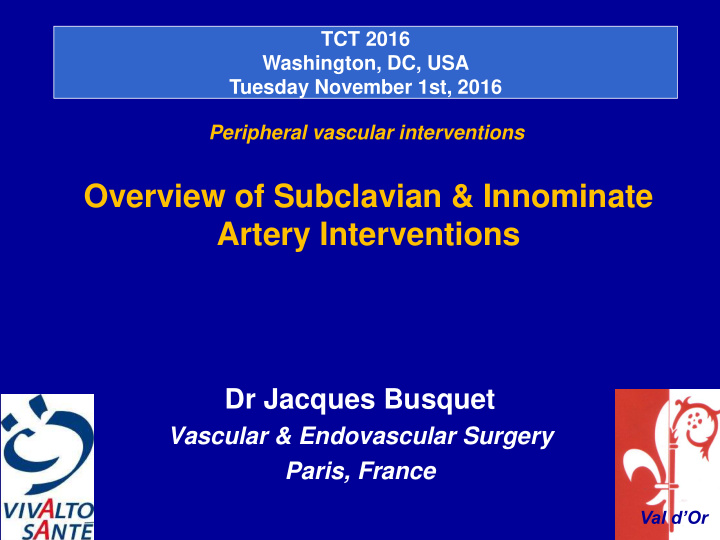



TCT 2016 Washington, DC, USA Tuesday November 1st, 2016 Peripheral vascular interventions Overview of Subclavian & Innominate Artery Interventions Dr Jacques Busquet Vascular & Endovascular Surgery Paris, France Val d’Or
Disclosure None Related to this presentation TCT 2016
Subtotally occluded calcified ostial left subclavian artery Accessible to endovascular revascularization
Subtotally occluded calcified ostial left subclavian artery Accessible to endovascular revascularization Femoral Access
Subtotally occluded calcified ostial left subclavian artery Brachial Access Accessible to percutaneous endovascular revascularization
Supra-aortic truncks Left Subclavian Artery
Supra-aortic truncks Innominate Artery
Angio CT 3D Reconstruction
Duplex Scan Examination
Transcranial examination
Arterial Supra-Aortic Truncks 20% 20% Distribution of Atheromatous Disease Fields WS, Lemak NA. Joint study of extracranial arterial occclusion JAMA 1972; 222:1139-1143
Severe Proximal Innominate Artery Stenosis
Angioplasty & Stenting of Innominate Artery Open Retrograde Access with Clamping of Common Carotid Artery for Cerebral Protection
Subclavian Artery Occlusive Disease
Fischer CM A New Vascular Syndrome “ the Subclavian Steal ” N Engl J Med 1961;265:912-913
Subclavian Steal Definition Severe Stenosis or Occlusion of Pre-Vertebral Subclavian Artery Reversed Flow in Vertebral Artery with Re-Injection of Subclavian Artery
Subclavian Steal Syndrome Non-Predictive of Neurovascular Events Marker of Atheromatous Disease Hennevici M, Klemm C, Rantengerg W The Sub-Clavian Steal Phenomenon: A Common Vascular Disorder with Rare Neurologic Deficit Neurology 1988;38:669-673
Subclavian Steal Hemodynamic Sequence
Subclavian Steno-Thrombosis
Reversed Vertebral Flow
Subclavian Re-Injection
Surgical Revascularization Subclavian Artery • Transversal Cervicotomy • Carotido-Subclavian Transposition • Carotido-Subclavian Bypass Inomminate Artery • Sternotomy • Aorto-Inomminate Artery Bypass • Endarterectomy
Kieffer E, Sabatier J, Koskas F, Bahnini A Atherosclerotic Innominate Artery Occlusive Disease: Early and Long-Term Results of Surgical Reconstruction J Vasc Surg 1995 ; 21 : 326-337 148 patients operated for atherosclerotic lesions of supra-aortic truncks over a period of 20 years Post-operative mortality was 5.4% Survival rate was 77.5% at 5 years and 51.9% at 10 years follow-up Late mortality is essentially caused by myocardial infarction (12% of the cases).
Laurian C, Cron J, Gigou C et al Atherosclerotic Lesions of the Subclavian Artery: Role of the Carotid-Subclavian Arterial Transposition J Mal Vasc 1998 ; 23 : 263-68 Carotido-subclavian transposition with a global patency rate of 96% at 5 years follow-up is justified as a first-choice technique in the treatment of subclavian artery obstructions
Carotid-Subclavian Direct Surgical Transposition Common Carotid Vertebral Artery Subclavian Artery
Operative Risks • Coronary Risk • Lymphatic Risk Left Subclavian Artery • Neurologic Risk Right Subclavian Artery
Balloon Angioplasty First Case Report Bachman DM, Kim RM Transluminal Dilatation for Subclavian Steal Syndrome AJR Am J Roentgenol 1980;135:995-996
Angioplasty & Stenting Motarjeme A . Percutaneous transluminal angioplasty of supra-aortic vessels. J Endovasc Surg. 1996;3:171-181 Criado FJ, Queral L . The role of angioplasty and stenting in the treatment of occlusive lesions of supra-aortic truncks. J Mal Vasc. 1996;21:132-13 Rodriguez-Lopez JA, Werner R, Toruella L, Ray L, Diethrich EB . Stenting of atherosclerotic occlusive disease of the subclavian artery. Ann Vasc Surg 1999;13:254-260
Subclavian Steal 3 Steps • Permanent Steal Reversed Vertebral Flow • Intermittent Steal Biphasic Flow • Pre-Steal T est of Hyperhemia
Symptoms • Cervical bruit • No radial pulse • Arm-to-arm BP difference 20-30mmHg • Paresthesia of upper limb • Induced with arm exercice • Dizziness • Drop attack • Syncope
Case # 1 62 years old woman Light tabagism 2 years follow-up Progressive Subclavian Stenosis 60% 80% Anisotension Vertigo > Syncope Right arm claudication
Anatomical Variant Arteria Lusoria 80% Prevertebral Proximal Stenosis
Arteria Lusoria Intermittent Right Subclavian Steal
Arteria Lusoria Intermittent Right Subclavian Steal
Arteria Lusoria Intermittent Right Subclavian Steal
Arteria Lusoria Intermittent Right Subclavian Steal
Humeral puncture Local Anesthesia Long Sheath Heparinization
Angiographic Confirmation of the Lesion
Primary Stenting with balloon 7mm/40mm
Post Procedural Angiographic Control
Case report # 2 79 years old woman Autonomous Recurrent Syncopes Normal Cerebral CT Normal Electrophysiology Initial Duplex Scan Underestimated
Restenosis Rate From 4.5 to 14.6% Follow up 14 to 36 months V.M. Ochoa et al, Vascular Medecine 2010,16 1: 29-34
Subclavian Coronary Steal Syndrome Diethrich EB, Cozacov JC . Subclavian stent implantation to alleviate coronary steal through a patent internal mammary artery graft. J Endovasc Surg 1995;2:77-80 Left Subclavian Angioplasty to restore coronary flow in the affected LIMA graft
LSA Branch Thoracic Stent Graft Frank Arko III, MD, Charlotte, NC, USA
Conclusion Role of Duplex Scan Surveillance of Asymptomatic Lesions Indications for Surgical Revascularization Transposition or bypass Endovascular Techniques Humeral Percutaneous Access Short Inflation - Vertebral Protection A new deal regarding anatomical fixation of thoracic endograft
Recommend
More recommend